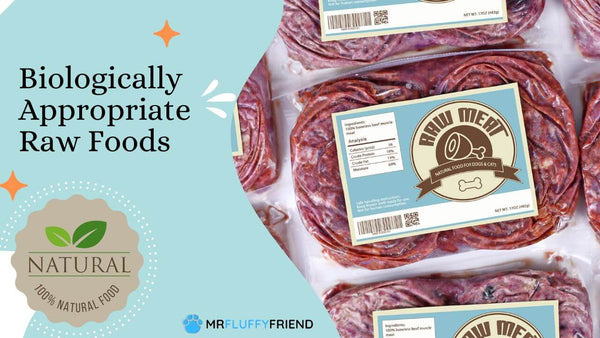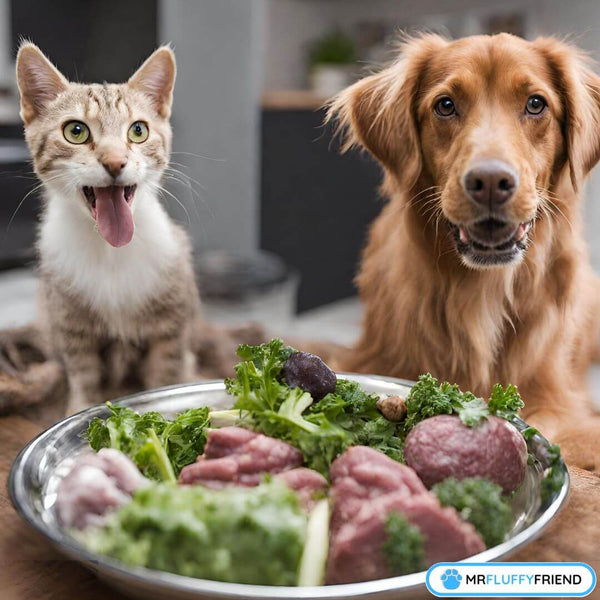BARF 101: Biologically Appropriate Raw Foods
In recent years, many cat and dog owners have turned to alternative diets that seek to copy what their pets might’ve consumed in the wild.
One such diet gaining traction is the BARF diet (Biologically Appropriate Raw Foods or Bones and Raw Food).
BARF is more than just a catchy acronym; it’s a feeding approach prioritising raw, natural ingredients tailored to a carnivore's biological needs.
Let’s look into the following (click the links below to go to that section):

Understanding BARF
Founded by Australian veterinarian Ian Billinghurst, BARF believes that pet dogs and cats do best with diets similar to what their wild ancestors ate.
This means lots of raw bones, meats, and organs and not much plant-based food.
Unlike commercial pet foods with additives and processed ingredients, BARF focuses on natural, unprocessed food.
Components of a BARF Diet:

- Raw Meat:
The cornerstone of BARF is raw meat-based diets.
This provides essential proteins, amino acids, and fats vital for muscle development, energy, and overall health.
Varieties like beef, chicken, turkey, lamb, and fish are commonly included, with some owners choosing exotic meats like venison or rabbit.
- Bones:
Raw, uncooked bones are integral to a BARF diet.
They’re a natural source of calcium, phosphorus, and other minerals necessary for bone health and dental hygiene.
However, selecting bones appropriate for your pet's size and chewing ability is crucial to prevent choking or dental injuries.
- Internal Organs:
Organs (liver, kidney, heart, and spleen) are packed with vitamins, minerals, and essential fatty acids.
They provide key nutrients like vitamins A and B, iron, and taurine, which are essential for optimal organ function and overall well-being.
- Fresh Fruits and Vegetables (Optional):
While carnivores primarily thrive on animal-based diets, some BARF proponents add small amounts of fruits and vegetables.
These products add fibre, antioxidants, and phytonutrients to the BARF diet.
Still, these should be limited as excessive plant matter can disrupt the carnivore's digestive system.
Related: How To Deal with Cat Separation Anxiety
Pros and Cons of BARF
You need to consider the pros and cons of a raw food diet so you can make an informed decision that prioritises your pets' health, safety, and well-being.
Let’s evaluate:
Pros of BARF:

- Nutritional Superiority:
BARF diets aim to replicate the natural, species-appropriate diet of carnivorous animals.
In turn, this diet provides essential nutrients in their raw and unprocessed forms.
This can result in improved health for pets.
- Improved Digestion:
Among the benefits of raw food diet is its digestibility.
Raw foods are generally easier for pets to digest than processed commercial diets.
This could reduce the risk of gastrointestinal issues like bloating, gas, and diarrhoea.
- Dental Health Benefits:
Chewing on raw bones can help clean teeth, massage gums, and prevent the build-up of plaque and tartar.
This can promote better dental hygiene and reduce the risk of periodontal disease.
Still, many dental toys can also aid in keeping your pup’s teeth clean.
Some of these toys even dispense treats.
- Healthier Skin and Coat:
BARF diets can contribute to healthier skin and a shinier coat.
If your pup’s skin and coat are healthy, they’re less likely to itch or flake.
- Enhanced Immune Function:
Nutrient-dense ingredients in BARF diets (vitamins, minerals, and antioxidants) can support a strong immune system.
A robust immune system can help pets resist infections and illnesses more effectively.
- Weight Management:
BARF diets are usually lower in carbohydrates and higher in protein.
This can help pets maintain a healthy weight and prevent obesity.
Cons of BARF:

- Nutritional Imbalance:
Formulating balanced homemade raw diets requires careful planning and supplementation.
You need to ensure that your pets receive all essential nutrients in the proper proportions.
Without proper knowledge and guidance, there’s a risk of nutritional deficiencies or excesses.
- Food Safety Concerns:
Take note that if you feed your pet a raw diet, there’s a higher risk of bacterial contamination.
Harmful bacteria like Salmonella, E. coli, and Campylobacter are health risks to pets and humans.
Proper handling, storage, and hygiene practices are needed to minimise the risk of foodborne illness.
- Cost:
BARF diets can be more expensive than commercial dog food.
This is particularly true when sourcing high quality, human-grade ingredients.
Factor in the cost of raw ingredients, supplements, and veterinary care when budgeting for a BARF diet.
- Time and Effort:
Preparing homemade raw food requires time, effort, and storage space.
Ask yourself if this is possible for your space and lifestyle.
Commercial raw pet food options are available but may be costly for some.
- Feeding Challenges:
Some pets may have difficulty transitioning to a BARF diet.
Also, some may not tolerate certain raw ingredients well.
As we always say, all pets are unique and have different dietary preferences.
You also need to consider any health issues your pet may have.
- Regulatory Issues:
The production and sale of raw pet food are subject to fewer regulations.
The quality control standards are also limited compared to commercial food.
This might be challenging for pet owners who’d like to be sure about the safety and quality of raw food products.
Related: Dog Feeding 101: Choose the Right Food for Your Dog
Implementing a BARF Diet:
Disclaimer:
Before starting your pets on raw meat-based diets, doing lots of research is always a good thing.
Ask your veterinarian if your pet can transition to the BARF diet.
Transitioning to a BARF diet requires careful planning and consideration.
You must ensure the transition will be a smooth adjustment for your pet.
Follow these steps to implement a BARF diet effectively:

- Research:
Familiarise yourself with the principles of BARF.
Consult a veterinarian or animal nutritionist experienced in raw feeding if you have concerns or questions.
- Gradual Transition:
Introduce BARF gradually by mixing small amounts of raw food with your pet's current diet.
Slowly increase the proportion of raw food over several days.
This will allow your pet's digestive tract to adjust.
- Variety is Key:
Offer a diverse range of proteins for a balanced diet.
Include different types of meat, organs, and bones.
Aim for variety in texture, flavour, and nutrient composition to mimic the diversity of a wild diet.
Keep a hygienic water bowl close by.
- Monitor Your Cat or Dog’s Health:
Monitor your pet's health and well-being during and after the transition period.
Look for signs of allergies, intolerances, or digestive upset.
Adjust as needed to tailor the diet to your pet's needs.
- Food Safety:
Handle raw food with care to minimise the risk of bacterial contamination.
Wash your hands, food utensils, and preparation surfaces thoroughly after handling raw meat.
Store raw food appropriately to prevent spoilage and foodborne illness.
Don’t forget to wash your pet’s food bowl after every meal.
Related: 5 Reasons Why Your Cat Is Not Eating

Conclusion
The BARF diet offers a good alternative for pet owners who’d like to give their best friend a nutritionally rich and biologically appropriate diet.
While it has many health benefits, it's essential to carefully consider the cons of raw feeding.
When it comes to your pets, always choose what’s best for them.
Stay tuned for more blog posts about BARF!
Looking for some products that could help you out?
Check out our Online Shop!
Here are some useful products in relation to this blog post:
MrFluffyFriend - Teeth Cleaning Dog Balls

3 comments
Can you tell me how much will this food will cost? And what ingredients are in this food Barf for dogs?
——-
MrFluffyFriend™ replied:
Hi Lillian,
The price typically starts at £2.00 for a 500g tub. In the US, the price starts at $3.00. The ingredients would depend on the manufacturer. :)
Can pork be fed to dogs? Cooked.
———
MrFluffyFriend™ replied:
Hey Randi,
Yes, dogs can eat cooked pork… no need to add seasonings.
We currently have a Husky/Akita bitch. I follow my Mother’s practice regarding feeding the dog I have, also the dogs I have had over my lifetime. That is to include raw mince. She also gets a thinly sliced eating apple everyday, which she really enjoys.